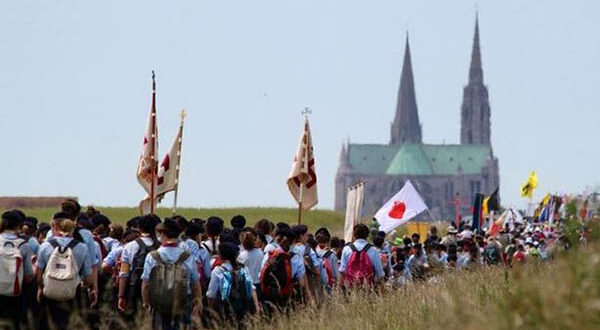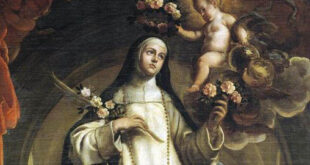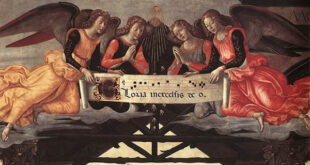Introduction: A March Toward God, Against the Tide
In a time marked by noise, haste, and spiritual confusion, thousands of Catholics of all ages, backgrounds, and countries set out to do something that seems crazy in the eyes of the modern world: walk more than 100 kilometers in three days, from Paris to Chartres, guided by faith, sustained by tradition, inspired by hope, and united in love for Christ and His Most Holy Mother.
The pilgrimage to Chartres is not just a devotional walk. It is a silent yet firm cry of fidelity to the Tradition of the Church, a school of holiness, a temporary desert where souls are purified, a living testimony that the Faith is not dead, and a concrete way of resisting the worldliness of our age.
Today, more than ever, it is urgent to rediscover the spiritual, theological, and pastoral value of pilgrimage, and Chartres is undoubtedly one of the most powerful and meaningful examples.
I. Origin and History of the Chartres Pilgrimage
The city of Chartres, in the heart of France, has been one of the most important Marian centers in Europe for centuries. Its majestic Gothic cathedral, dedicated to Notre-Dame (Our Lady), houses the venerated relic of the veil of the Virgin Mary, which, according to tradition, was brought there by Charles the Bald in the 9th century.
Although medieval pilgrimages to Chartres were already frequent, the traditional Pentecost pilgrimage from Paris began in the 20th century, especially as a response to the post-conciliar crisis that affected many faithful. It was first organized in 1983 by the traditionalist Catholic group Notre-Dame de Chrétienté, and since then it has become a global reference point for spiritual renewal, especially among young people.
Each year, during Pentecost weekend, more than 15,000 pilgrims, mostly young people, gather to walk over 100 kilometers in three days—a titanic physical and spiritual effort centered on the Traditional Latin Mass, Gregorian chant, praying the Rosary, confessions, doctrinal teachings, and, above all, interior silence.
II. Theological Relevance: A March Toward the Heights
The pilgrimage to Chartres is not just an act of piety; it is a moving catechesis, a theological act lived out with the feet, the heart, and the soul.
1. Image of the Pilgrim Church
As the Second Vatican Council reminds us in Lumen Gentium, the Church is a pilgrim people, journeying toward the heavenly Jerusalem. In Chartres, this image becomes tangible: each pilgrim represents a part of that body advancing together toward the goal, through falls and fatigue, but sustained by grace.
“For we have here no lasting city, but we seek the one that is to come.” (Hebrews 13:14)
Chartres teaches, through bodily experience, that Christianity is not an ideology or abstract feeling: it is a way (cf. Jn 14:6), a continual exodus that requires effort, renunciation, community, obedience, prayer, and sacrifice.
2. Redemptive Suffering and Offering
During the pilgrimage, every physical pain—blisters, thirst, sun, fatigue—is an opportunity to unite with the Cross of Christ, offering that suffering for the conversion of sinners, vocations, the family, or personal sins. The pilgrimage becomes a lived liturgy, in which the body accompanies the soul in its ascent.
“I complete in my flesh what is lacking in the sufferings of Christ, for the sake of His Body, which is the Church.” (Colossians 1:24)
3. Fidelity to Tradition
One of the distinguishing marks of Chartres is its adherence to the Tridentine Mass, celebrated with reverence, beauty, and theological depth. This is not a gesture of nostalgia but an affirmation that lex orandi (the law of prayer) shapes lex credendi (the law of belief). In a world where liturgy has often been trivialized, Chartres shows the path of a liturgy that educates, elevates, and sanctifies.
III. Practical Applications: How to Live “Chartres” Every Day
Although not everyone can physically make the pilgrimage to Chartres, everyone can spiritually live the logic of pilgrimage in their daily lives. How?
1. Make Your Life a Pilgrimage
Remember that you are passing through. Live with sobriety, inner detachment, and hope. Do not place your heart in passing things. Every day is a step toward eternity.
2. Offer Your Sacrifices
As in Chartres, offer your daily fatigue, work difficulties, family struggles as part of your walk toward God. Unite everything to the Cross of Christ. Live with a spirit of expiation and reparation.
3. Walk with Others
In the pilgrimage, no one walks alone. Likewise, in the Christian life, it is vital to walk in community, especially in these times of confusion. Lean on your brothers and sisters in the faith. Participate in the sacraments. Be an active part of your parish or a committed Catholic group.
4. Rediscover the Liturgy
Learn to value the richness of the traditional liturgy. If possible, attend the Tridentine Mass. If not, at least live every Eucharist with reverence, recollection, and love for the mystery. Well-lived liturgy transforms the soul.

IV. Practical Guide to Making the Pilgrimage to Chartres
Would you like to live Chartres in body and soul? Here is a practical and pastoral guide to prepare for your pilgrimage.
A. Spiritual Preparation
- Confession beforehand: Do not begin the journey without reconciling with God.
- Personal prayer: Dedicate time each day in the weeks leading up to the pilgrimage to pray, meditate, and make offerings.
- Clear intention: Carry specific intentions (family, vocations, penance…).
- Spiritual reading: Bring books like The Imitation of Christ, The Spiritual Combat, or writings of the Church Fathers.
B. Physical Preparation
- Walk several kilometers a day for at least a month beforehand.
- Use the shoes you plan to wear during Chartres.
- Learn to care for your feet: talcum powder, cream, double socks, and blister patches.
C. Equipment
- Lightweight backpack (under 8 kg), canteen, hat, sleeping bag.
- Rosary, prayer book, small Bible or New Testament.
- Do not bring superfluous items. Learn to walk with what is essential.
D. During the Pilgrimage
- Respect silence during times of prayer.
- Sing, pray, and listen to the meditations.
- Offer each day for a different intention.
- Do not complain. Everything is grace.
- Remember that this is not a hike, but an act of worship and a sacrifice offered.
E. After the Pilgrimage
- Keep the pilgrim spirit alive. Do not return the same.
- Continue with daily prayer, sacrifice, and sacramental life.
- Share your experience. Invite others to live it.
Conclusion: Chartres, a Beacon in the Darkness
In a tired and aging Europe, the pilgrimage to Chartres is a beacon of light. Not only because of the beauty of its destination, but because thousands of young people, families, priests, and consecrated souls march with hearts ablaze, wordlessly proclaiming that the Catholic Faith is not dead. On the contrary: it is being reborn.
Chartres is much more than a walk. It is a radical spiritual exercise, an exorcism against lukewarmness, a humble and glorious response to the call of the Gospel:
“If anyone would come after me, let him deny himself, take up his cross, and follow me.” (Matthew 16:24)
May we all, in our daily lives, unite ourselves to this spiritual pilgrimage, in which, step by step, we draw closer to the heart of God.






